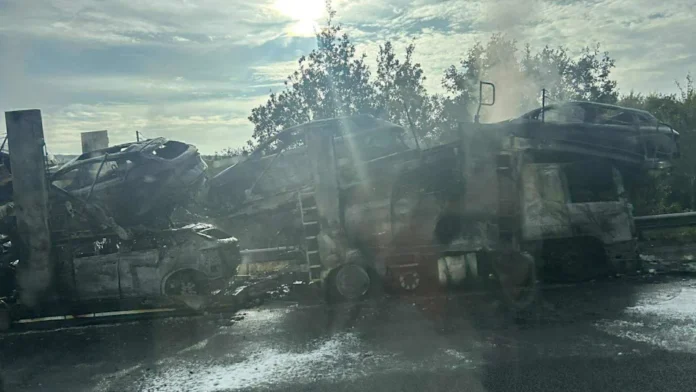It was supposed to be an ordinary morning commute on the M5 through Devon. But just after sunrise, drivers were forced to slam on their brakes as thick black smoke poured across the motorway. A car transporter carrying nine electric vehicles had caught fire, and within minutes, a stretch of one of the region’s busiest roads was turned into a scene of chaos and disbelief.
The Fire That Stopped the M5
The blaze erupted shortly after 6:30 a.m. on the southbound carriageway between junction 28 at Cullompton and junction 29 for Exeter. According to Devon and Cornwall Police, both directions of the motorway had to be shut down for safety.
Five fire crews from Devon and Somerset Fire and Rescue rushed to the scene. Witnesses described seeing a towering fireball as the transporter’s cargo—nine electric cars—was engulfed in flames. For commuters caught in traffic, it wasn’t just a delay. It was an unsettling reminder of how fast a morning can change when fire takes control.
Dan Cooke, a driver stuck in the gridlock, said the scene was unforgettable. “Plumes of smoke, big black smoke, so we all slowed down, and it was a big fireball that went up straight away, exploding across the M5. It was almost like a firework show.”
His words carried both awe and fear. Because when you see something like that on a motorway you drive every day, it stays with you.
Emergency Response: A Race Against the Flames
By the time firefighters arrived, the transporter was already fully ablaze. Crews battled flames that leapt into the air, fueled by the cars strapped to the lorry. Drivers who had been forced to stop watched from a safe distance as blue-light vehicles crowded the scene.
“It’s still smouldering but looks completely destroyed, to be honest,” Cooke added. His description captured the stark reality by the time the fire was under control, much of the transporter and its cargo had been reduced to charred metal.
National Highways quickly announced diversions through Cullompton, Westcott, Budlake, and Broadclyst. But that did little to ease the traffic nightmare. Devon County Council reported heavy congestion on the alternative routes, with Bickleigh Bridge on the A396 facing severe delays. For many, what should have been a straightforward trip turned into a long morning of waiting, frustration, and rerouting.
The Electric Vehicle Question
Any fire involving vehicles raises concerns, but this one had an extra layer of complexity. The transporter was carrying nine electric cars, and while officials have not confirmed whether the vehicles themselves triggered the blaze, the incident has renewed conversations around electric vehicle (EV) safety.
EV fires are relatively rare, but when they do occur, they can burn hotter and longer due to lithium-ion batteries. Firefighters are trained to handle such situations, but these blazes often require more water, more time, and more caution compared to petrol or diesel vehicle fires.
It’s important to remember, though, that conventional vehicles catch fire far more often than EVs. What really stands out here is the sheer scale—nine cars, stacked together on one transporter, magnifying the impact of a single fire.
If you’ve ever smelled burning rubber or seen smoke curling from the bonnet of a car, you know how alarming it feels. Multiply that by nine vehicles, and you can imagine why this incident brought the motorway to a standstill.
Lessons From the M5 Fire
When you step back, this isn’t just about one lorry fire. It’s about the broader lessons in fire safety awareness, for drivers, businesses, and communities alike.
-
Preparedness saves time and lives. The quick response of five fire crews ensured the blaze didn’t spread beyond the transporter or cause injuries. Emergency services train for these moments, and Tuesday morning showed why that training matters.
-
EVs require different fire tactics. As electric cars become more common, incidents like this highlight the importance of updated training and equipment for firefighters. Suppressing a lithium-ion fire isn’t the same as extinguishing a petrol engine blaze.
-
Infrastructure is vulnerable. One lorry fire closed a critical stretch of the M5 for hours. That’s a reminder that major roads are lifelines, and when they’re disrupted, thousands of people feel the ripple effect.
What Drivers Can Do to Stay Safe
Not every driver will encounter something this dramatic on their morning commute, but fires on the road aren’t as rare as you might think. Here are some takeaways anyone can apply:
-
Stay alert in traffic. If you see smoke or flames ahead, keep your distance. It’s tempting to creep closer out of curiosity, but safety comes first.
-
Carry an extinguisher. A small car fire extinguisher may not stop a full blaze, but it could control a minor spark before it escalates.
-
Know the signs. Burning smells, dashboard warnings, or unusual smoke should never be ignored. Pull over and call for help.
-
Plan your routes. In the case of a major motorway closure, always have an idea of alternative roads. Navigation apps can help, but diversions can still clog up fast.
The Ripple Effect on Devon’s Communities
This wasn’t just an inconvenience for commuters. It was a disruption that affected deliveries, business operations, and even school runs. Devon County Council noted unusually high traffic volumes across diversion routes, with small roads bearing the brunt of rerouted vehicles.
For rural communities like Cullompton and Broadclyst, a sudden surge in traffic can be more than just a headache. It can clog narrow lanes, delay emergency responses in other areas, and increase the risk of secondary accidents.
So while the fire itself was the central event, its impact stretched far beyond the smoke-filled motorway. It touched local towns, businesses, and families who had no direct connection to the incident.
Why Fire Incident News Like This Matters
Some might shrug and say, “It was just a lorry fire.” But the bigger picture is about awareness.
Every fire incident news story carries a lesson. For Devon, this one was a reminder of how fragile our infrastructure can be and how fast things can spiral when fire is involved. For drivers across the UK, it’s a chance to reflect on their own safety practices and the evolving challenges of modern transport.
If you’ve ever been caught in traffic because of a fire, you know the mix of frustration and relief—you’re annoyed at the delay but grateful it wasn’t your vehicle. That mix of emotions is what drives home the reality: fires can happen to anyone, anywhere, anytime.
Closing Thoughts: A Wake-Up Call on Fire Safety
The M5 fire will be remembered for the sight of nine cars burning on a transporter, smoke billowing across the motorway, and thousands of commuters left stranded. But what really matters is the reminder it gives us all.
Fire doesn’t wait for convenience. It doesn’t care about morning routines, school runs, or delivery schedules. It just happens. And when it does, preparation and awareness make all the difference.
So, what can we learn from this fire? That communities rely on firefighters more than we realize. That new technologies like electric vehicles come with new challenges. And that every driver should think about fire safety—not just at home, but on the road too.
The next time you head out on the motorway, take a moment to think: Am I prepared if something unexpected happens? Because if Bedford’s attic fire reminded us about home safety, the M5 transporter blaze reminds us about road safety.
And those are lessons none of us can afford to ignore.

